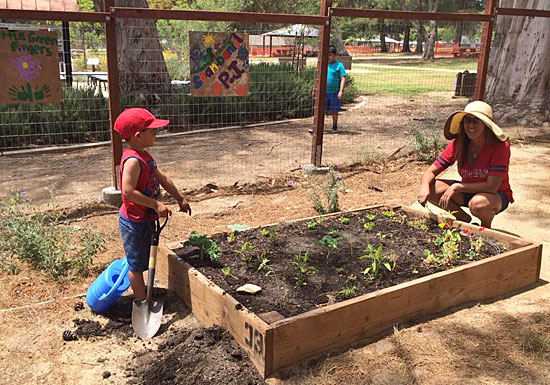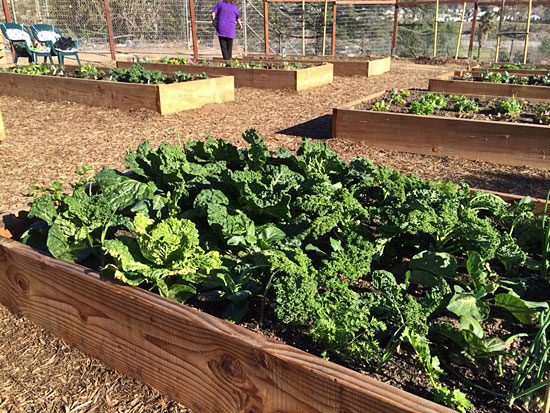Garden grows more than just plants

The green thumbs start young at El Cariso’s new garden, which is being inaugurated this weekend.
It’s difficult to predict just how a garden will grow. At Sylmar’s new El Cariso Mountain Garden, they’re harvesting not just tasty veggies but also stronger community bonds.
The garden, which is having its grand opening celebration on Saturday, features 39 raised beds, fruit trees, play areas and even a tricycle path. It’s the latest product of the Little Green Fingers Collaborative, a joint effort by the Los Angeles Conservation Corps and the L.A. Neighborhood Land Trust to serve local families with young children.
And those families have responded enthusiastically.
Wendy Lynch signed up for a plot in part to teach her kids—Travis, 5, and Mbali, 2—where their food comes from.
“Kids love dirt and water, so it’s a ton of fun,” Lynch says. One plot is set aside for “kids to just play and turn the dirt over. It’s filled with kid-proof plants.”
Lynch discovered the garden last fall when it was being built. Her parents spotted the construction in a seldom-used corner of the county’s El Cariso Community Regional Park during their daily walk along the park’s bike path. “They called me up and said ‘You have to get down here,’ ” Lynch recalls.
Lynch, a self-described stay-at-home mom, said she treasures her work in helping to manage the garden, of which she is the current co-treasurer.
“I miss that kind of thing, not working,” Lynch says. “This gives me a real sense of being productive.”
Getting folks like Lynch to grab the reins is essential to the long-term survival of the garden, according to Juan Salas, an organizer with the collaborative. The project is funded through 2017 by First 5 L.A., but then it will be handed over to the community to manage. The gardeners will have to raise the necessary funds to keep things growing.
Another community member, Liziel Estrada, already has helped the garden score a major grant. Estrada discovered and applied for a Grow Your Park grant from the National Recreation and Parks Association. The El Cariso garden was awarded $10,000, making it one of only 15 organizations nationwide to receive a grant. The gardeners plan to use the money to build a gazebo, add new features and continue battling what, so far, has been the biggest threat to a successful harvest—a persistent gopher and rabbit problem.
“The first three months that the gardeners were planting things, they noticed that there were no leaves,” organizer Salas says. “Gophers would pull the plant straight underground just like in the cartoons. I never knew it happened like that but it actually does.”
Additional fencing and wiring installed at the base of the garden beds seems to be helping, and the garden is now growing lush and green. Such challenges are not necessarily a bad thing because they serve as important learning experiences for the young kids who are the primary target of the initiative, says Jessica Monge, who oversees the project for First 5 L.A.
Beyond the open-air fun it offers, the program also aims to combat childhood obesity by promoting healthy eating at home. To that end, hands-on nutrition and cooking classes are part of the program. Estrada says her family has already reaped some of the benefits.
“We’ve had some carrots, we have some kale right now, we’ve had some lettuce,” Estrada says. “Seeing everything grow makes my son want to eat fruits and vegetables even more, which is great.”
But for her fellow gardener Lynch, the most unexpected benefits of the program have been the new connections she’s made.
“When you live in a house you know your immediate neighbors but you don’t meet your community,” Lynch says. “I didn’t know we had a Neighborhood Council; now I know who to go to if I want to get things done. I’ve also made a lot of new friends. With kids, sometimes it’s hard to know who you can trust. You get to see what kind of people they are when they’re working the garden.”
The Sylmar project is the fourth Little Green Fingers garden (others are in Koreatown, South L.A. and Pasadena) and the first to be located in a park.
Most of the garden’s plots already have been reserved by neighborhood families, a school and two local organizations, but those interested in digging in can email Juan Salas (jsalas@lanlt.org) or Monica Curiel (mcuriel@lanlt.org.) Or they can attend Saturday’s grand opening, from 10 a.m. to 2 p.m. at the western edge of El Cariso Park, 13100 Hubbard Street. There will be educational displays, arts and crafts for kids, and a free lunch prepared by one of the gardeners who is an executive chef at a local restaurant. Picnic blankets are highly recommended.

Leafy green kale is just one of the crops coming up at the El Cariso Mountain Garden.
Posted 5/15/14






